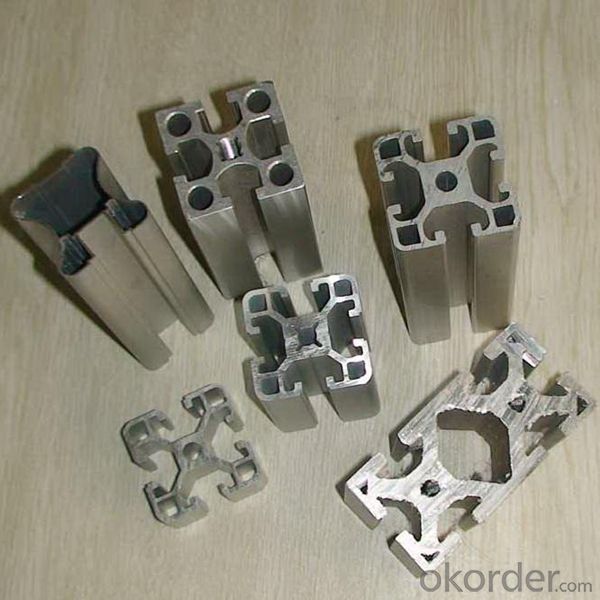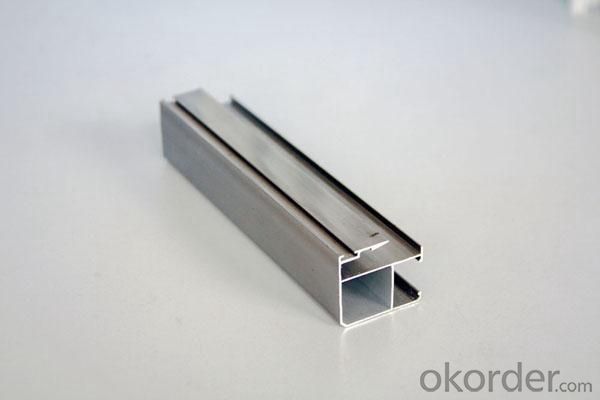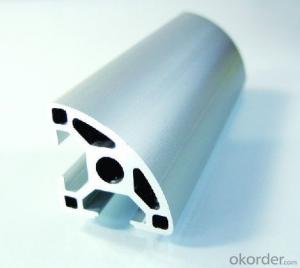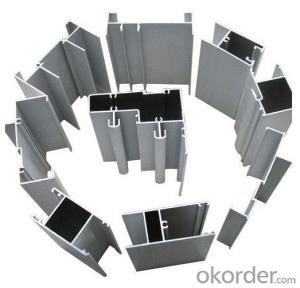Aluminum Profiles Made in China Alloy 6 Series
- Loading Port:
- Shanghai
- Payment Terms:
- TT OR LC
- Min Order Qty:
- 1 m.t.
- Supply Capability:
- 1000 m.t./month
OKorder Service Pledge
OKorder Financial Service
You Might Also Like
Item specifice
1. Specification of Aluminum Profiles Made in China Alloy 6 Series
Alloy | State | Tensile Strength δbMpa | Non-proportional Stretching Stress(δp0.2Mpa) | Stretching rate (δ%) | Pattern Thickness (mm) | HV | HW |
No Less Than | |||||||
6061 | T4/T6 | 180/265 | 110/245 | 16/8 | - | - | - |
6063 | T5/T6 | 160/205 | 110/180 | 8/8 | 0.8/- | 58/- | 8/- |
6063A | T5/T6 | 200,190/230,220 | 160,150/190,180 | 5,5/5,4 | 0.8,0.8/-,- | 65,65/-,- | 10,10/-,- |
2. Application of Aluminum Profiles Made in China Alloy 6 Series
wall cladding, ceilings, bathrooms, kitchens and balconies, shutters, doors,windows…
3. Feature of Aluminum Profiles Made in China Alloy 6 Series
Surface Quality :
Be free from Oil Stain, Dent, Inclusion, Scratches, Stain, Oxide Decoration, Breaks, Corrosion, Roll Marks, Dirt Streaks and other defect which will interfere with use,
Mochenical Property:
Chemical Composite and Mechanical Property
4. Certificate:
SGS and ROHS(if client request, paid by client), MTC(plant provided), Certificate of Origin(FORM A, FORM E, CO), Bureau Veritas and SGS (if client request, paid by client), CIQS certificate
5. Image of Aluminum Profiles Made in China Alloy 6 Series


6. Package and shipping of Aluminum Profiles Made in China Alloy 6 Series
First, plastic cloth with drying agent inside; Second, Pearl Wool; Third, wooden cases with dry agent, fumigation wooden pallets, aluminum surface could cover blue PVC film
7. FAQ
Question 1: What is your MOQ?
We accept one ton per type for an order. But the detail we could negotiate.
Question 2: What is your normal terms of payment?
We always trade with you by T/T. But we also accept the L/C as you require.
Question 3: How many kinds of the surface treatment we can choose?
You could choose different color of powder coated. Anodized of black. matte silver, nature, champagne, bronze color. Mill finished. Wooden finished and printed.etc.
Question 4: Can you supply OEM services?
We offer OEM services for 17 years.
Question 5: How many days for opening the mould?
Normally about 10 days.According to the difficulty of your drawing.
Question 6: Can i choose the package what i want?
Yes, of course. We offer various kinds of package.e.g.PE foam. Shrink film. Wrapping paper.
But we would give you professional suggestion of package.
- Q:How much is the 60 series aluminum frame bridge standard size, how much is the size of the fan
- [60] galuminium Qianjin aluminum series insulating aluminum window size 60x53.5, window size 67.8x68.6.
- Q:What are the cost considerations for using aluminum profiles?
- Some cost considerations for using aluminum profiles include the initial cost of purchasing the profiles themselves, any additional costs for custom or specialized profiles, the cost of installation and assembly, maintenance costs, and potential future costs for repairs or replacements. Additionally, the cost of aluminum profiles may vary depending on the quality and thickness of the material used.
- Q:120 and 150 hidden frame glass curtain wall aluminum profile per square meter dosage, there may be curtain wall quotation cost analysis table
- Aluminum curtain wall is about 8-10kg/ square meters.I don't have any formAt present, the price of aluminum profile is 20-30 yuan /kg (anodizing, powder spraying, fluorocarbon spraying and other surface treatment)A window sash is glass, aluminum, metal fittings, glue, these things, aluminum, glass is accounted for the bulk
- Q:Measuring 3 meters long aluminum profiles of the straightness, you have what good method? What is the maximum deviation value allowed by our industry? In addition to the platform measurement, and what are the economic and practical methods, our factory stalls are small. Consider input costs.
- For bending, twist test should be adopted according to the requirements of the platform, but in actual use, the platform used as a simple test tube can also be used to forming good Aluminum Alloy square or rectangular, note the tube before use, the first to confirm the test, can be used as a test platform.
- Q:What are the different types of brackets used with aluminum profiles?
- There are several different types of brackets that are commonly used with aluminum profiles. These brackets serve various purposes and help in joining and securing the profiles to create sturdy structures. Some of the most common types of brackets used with aluminum profiles include: 1. Corner brackets: These brackets are used to connect two aluminum profiles at a right angle. They are typically L-shaped and provide a strong and stable connection. 2. T-slot nuts: These nuts are specially designed to fit into the T-slots of aluminum profiles. They allow for the attachment of various accessories and components to the profile, such as panels, hinges, or locks. 3. Angle brackets: Angle brackets are used to create connections between aluminum profiles at different angles other than 90 degrees. They are typically adjustable to accommodate various angles. 4. Joining plates: Joining plates are used to connect two or more aluminum profiles end-to-end, creating longer sections. These plates provide a secure connection and maintain the structural integrity of the profiles. 5. Gusset brackets: Gusset brackets are triangular brackets that are used to reinforce the connections between aluminum profiles. They provide additional strength and stability to the structure, particularly at joints. 6. Panel brackets: Panel brackets are used to attach panels or sheets to aluminum profiles. These brackets typically have a slot or groove that allows for the easy insertion and secure attachment of panels. 7. Mounting brackets: Mounting brackets are used to attach the aluminum profiles to walls, floors, or other surfaces. They provide a secure mounting point for the profiles, allowing for the creation of stable structures. These are just a few examples of the different types of brackets used with aluminum profiles. The specific type of bracket required will depend on the application and the desired structure being created with the aluminum profiles.
- Q:How do you calculate the weight-bearing capacity of aluminum profiles?
- When determining the weight-bearing capacity of aluminum profiles, several factors must be taken into account. These include the profile dimensions, the grade of aluminum used, and the specific requirements of the application. To start, it is necessary to ascertain the dimensions of the aluminum profile, including its length, width, and thickness. These measurements are crucial for calculating the cross-sectional area, a key parameter in determining the profile's load-bearing capacity. Next, the material grade of the aluminum used must be considered. Different aluminum alloys possess varying strength properties, so it is essential to know the specific alloy and temper designation. This information can be obtained from the manufacturer or supplier. Once the cross-sectional area and material grade are known, engineering standards or handbooks can be consulted. These resources provide load tables or formulas for calculating the safe load capacity of aluminum profiles. They offer a range of load ratings based on different loading conditions, such as static or dynamic loads, as well as factors like span length, support conditions, and safety factors. It is also crucial to take into account any additional factors that might affect the load-bearing capacity. These could include temperature, vibration, or potential impact forces. Adjustments to the calculated load capacity might be necessary to accommodate these factors. Furthermore, seeking advice from a structural engineer or an aluminum profile manufacturer can be highly beneficial. They can provide valuable insights and recommendations for more accurate calculations. They may possess specialized knowledge or testing data specific to the aluminum profile being considered, ensuring a more reliable assessment. In conclusion, calculating the weight-bearing capacity of aluminum profiles involves considering the dimensions, material grade, and specific application requirements. Consulting relevant resources or experts in the field is necessary to ensure accurate and safe load calculations.
- Q:Can aluminum profiles be used for solar power systems?
- Yes, aluminum profiles can be used for solar power systems. Aluminum is a widely used material in the construction of solar panels and their support structures. It is preferred for its lightweight nature, high strength-to-weight ratio, and excellent corrosion resistance. Aluminum profiles are often used for the framing and mounting of solar panels, as they provide structural stability and durability. Additionally, aluminum is easily recyclable, making it an environmentally friendly choice for solar power systems.
- Q:What are the different shapes and profiles available for aluminum profiles?
- There are various shapes and profiles available for aluminum profiles, including but not limited to T-shape, L-shape, square, rectangular, round, and oval. These profiles can have different dimensions and thicknesses to suit specific applications and design requirements.
- Q:What are the different bending options available for aluminum profiles?
- There are several bending options available for aluminum profiles, including cold bending, hot bending, and rotary draw bending. Cold bending is a common method that involves using a bending machine to gradually bend the aluminum profile without applying heat. Hot bending, on the other hand, requires heating the aluminum profile to a specific temperature before bending it. This method is usually used for thicker profiles or when tighter bending radii are required. Rotary draw bending is a precision bending technique that utilizes a mandrel and a rotating die to achieve accurate and consistent bends in aluminum profiles.
- Q:Can aluminum profiles be used for electrical cabinets?
- Yes, aluminum profiles can be used for electrical cabinets. Aluminum is a lightweight and durable material that offers excellent corrosion resistance and electrical conductivity, making it suitable for use in electrical cabinets. Additionally, aluminum profiles can be easily customized and fabricated to meet specific design and functional requirements of electrical cabinets.
1. Manufacturer Overview |
|
|---|---|
| Location | |
| Year Established | |
| Annual Output Value | |
| Main Markets | |
| Company Certifications | |
2. Manufacturer Certificates |
|
|---|---|
| a) Certification Name | |
| Range | |
| Reference | |
| Validity Period | |
3. Manufacturer Capability |
|
|---|---|
| a)Trade Capacity | |
| Nearest Port | |
| Export Percentage | |
| No.of Employees in Trade Department | |
| Language Spoken: | |
| b)Factory Information | |
| Factory Size: | |
| No. of Production Lines | |
| Contract Manufacturing | |
| Product Price Range | |
Send your message to us
Aluminum Profiles Made in China Alloy 6 Series
- Loading Port:
- Shanghai
- Payment Terms:
- TT OR LC
- Min Order Qty:
- 1 m.t.
- Supply Capability:
- 1000 m.t./month
OKorder Service Pledge
OKorder Financial Service
Similar products
New products
Hot products
Hot Searches
Related keywords






























